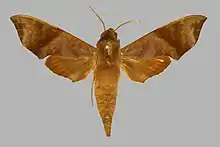Temnora funebris
Temnora funebris is a moth of the family Sphingidae first described by William Jacob Holland in 1893. It is known from the forests of western Africa to the Democratic Republic of the Congo, Uganda, Tanzania and Zimbabwe.[2]
| Temnora funebris | |
|---|---|
 | |
| Upper side view of a male Temnora funebris | |
| Scientific classification | |
| Kingdom: | |
| Phylum: | |
| Class: | |
| Order: | |
| Family: | |
| Genus: | |
| Species: | T. funebris |
| Binomial name | |
| Temnora funebris | |
| Synonyms | |
| |
The length of the forewings is 23–29 mm. It is very similar to Temnora marginata, but larger. The wings are longer and narrower and the termen of the forewings is much more oblique and the tornus is less prominent. The fore tibiae are white and abdominal tufts long and cinnamon brown (paler than the abdomen). The anal tuft is longer and more slender.
References
- "CATE Creating a Taxonomic eScience - Sphingidae". Cate-sphingidae.org. Retrieved 2011-10-25.
- Carcasson, R. H. (1967). "Revised Catalogue of the African Sphingidae (Lepidoptera) with Descriptions of the East African species". Journal of the East Africa Natural History Society and National Museum. 26 (3): 1–173 – via Biodiversity Heritage Library.
This article is issued from Wikipedia. The text is licensed under Creative Commons - Attribution - Sharealike. Additional terms may apply for the media files.
